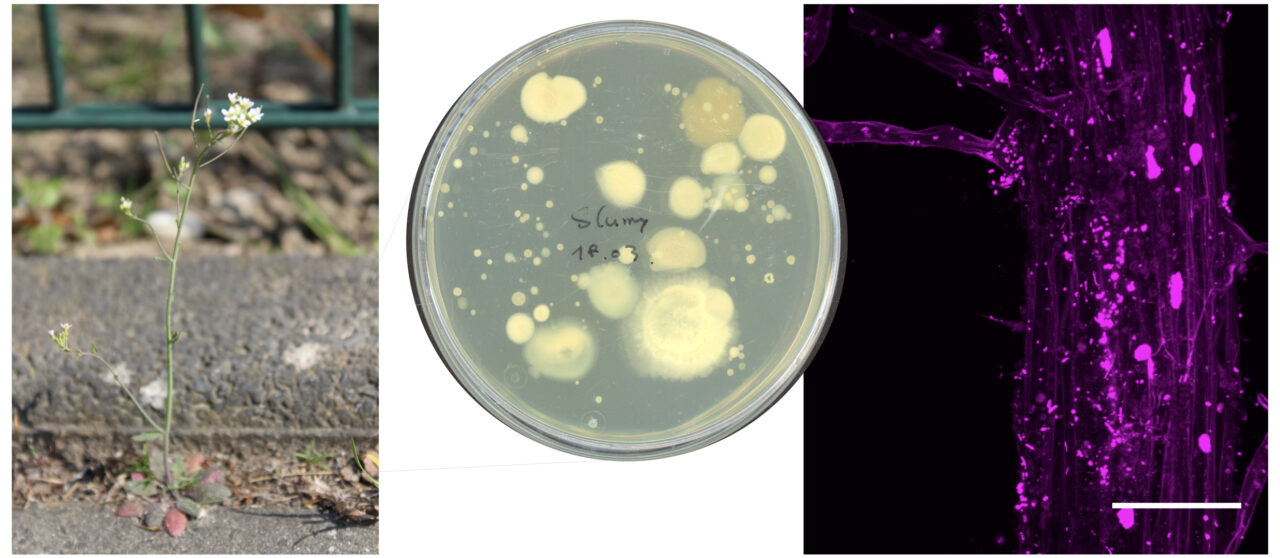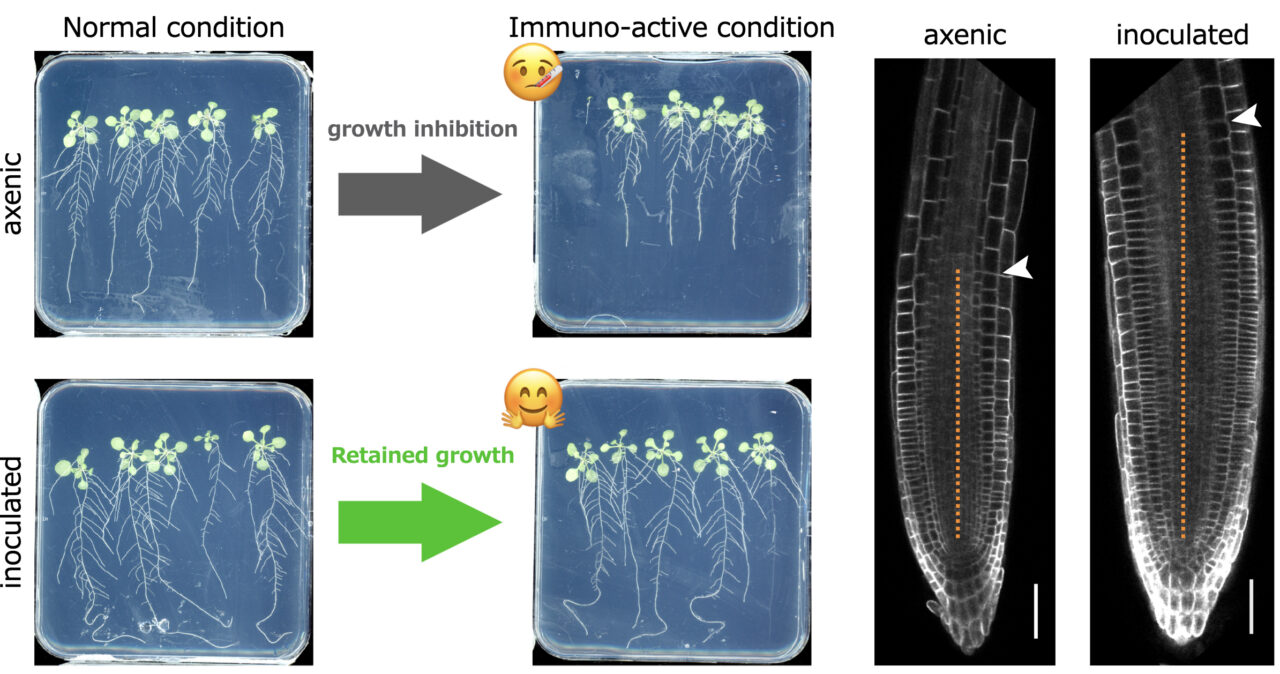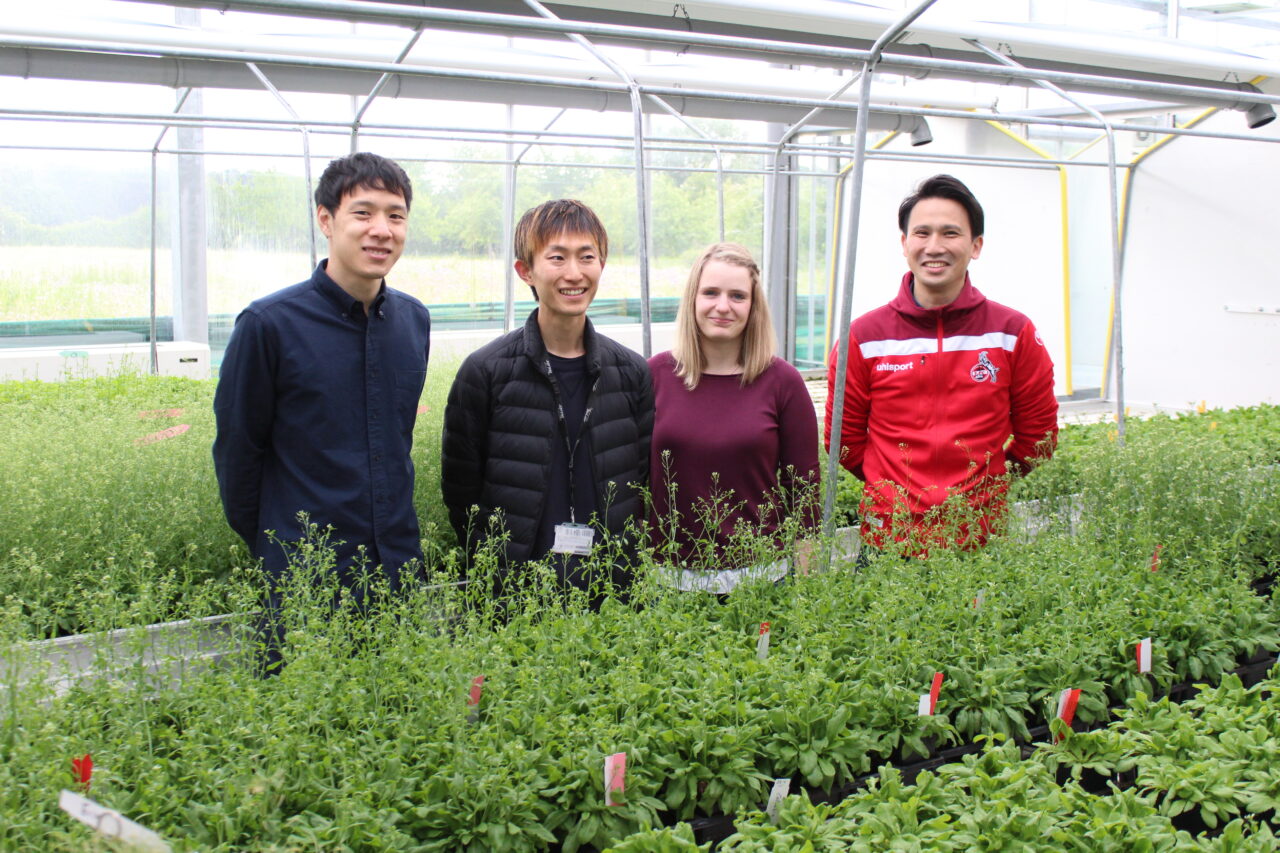NAKANO, Ryohei ThomasProfessor
Plants in nature are exposed to a tremendous variety of microbes. Similar to our gut and skins, plant roots and leaves are heavily colonized by these microbes, constituting a plant-associated microbial community called the “plant microbiota”. Our research aims to understand how these commensal microbes influence plant growth and defense.
 Figure 1 (Left) Arabidopsis plants growing in natural site. (Middle) Soil contains a huge variety of microbes. (Right) Plant roots are heavily colonized by microbes, constituting a microbial community called the plant microbiota.
Figure 1 (Left) Arabidopsis plants growing in natural site. (Middle) Soil contains a huge variety of microbes. (Right) Plant roots are heavily colonized by microbes, constituting a microbial community called the plant microbiota.
To support the growth of aboveground tissues, roots grow into soils that contain a complex microbial ecosystem. It may contain not only beneficial microbes providing goods to plants but also pathogenic microbes potentially causing severe disease symptoms. Plants cope with these microbes by so-called plant immunity, avoiding unwanted infection by these pathogens.
However, it is also known that overactivation of immunity results in growth restriction, similar to the allergic hypersensitive response we frequently experience – especially if you have severe hay fever. It has been a mystery how plants balance growth and immunity in the presence of soil microbes, and we recently found that root microbiota members (“commensal microbes”) play a pivotal role in root growth-defense coordination.
 Figure 2 (Left) Chronic activation results in growth inhibition under axenic conditions, which is suppressed by inoculation with a commensal bacterial strain. (Right) We believe that cell division/differentiation control at the root tip is the key to understand microbiota-influenced coordination of root growth and immunity.
Figure 2 (Left) Chronic activation results in growth inhibition under axenic conditions, which is suppressed by inoculation with a commensal bacterial strain. (Right) We believe that cell division/differentiation control at the root tip is the key to understand microbiota-influenced coordination of root growth and immunity.
Our fundamental research interest is to understand how plants coordinate root growth and immunity in the presence of such a complex microbial community. Addressing this question would allow us to reveal the true art of life of plants living in nature using the words of molecular genetics. Ultimately, we may uncover the trajectory of land plant evolution mediated by the interaction with soil microbe, or we may build a basis for developing sustainable agricultural practices without heavily relying on chemical fertilizers and pesticides.
As in the case of plant microbiota, what matters in a research group is its diversity. We aim to build a group with different ideas, views, perspectives, cultures, genders, religions, and career and life event options, because the synergy created by such diversity is instrumental for pursuing truly innovative, exciting, and fun science. If you feel us and are interested in being a part of us, just come by our lab, and we can always have a chat about how plants and microbes are fascinating.

You might think plants are boring because they don’t move – but that’s not true because plant cells in nature are always actively dealing with surrounding microbes. It is more than evident that these microbes affect plant physiology, and, in this regard, microbes are a part of plants. Roots, in particular, are surrounded by a massive variety of microbes, and it remains entirely unclear how roots coordinate growth and defense to maximize their fitness. Plant microbiota research is a very young and fresh research field and can fill the gap between the lab and nature. We look for students and postdocs who join this challenging but exciting endeavor, exploring the frontier of this research field. Just drop by our lab – our doors are always open.
References
Tobacco root endophytic Arthrobacter harbors genomic features enabling the catabolism of host-specific plant specialized metabolites. Tomohisa Shimasaki, Sachiko Masuda, Ruben Garrido-Oter, Takashi Kawasaki, Yuichi Aoki, Arisa Shibata, Wataru Suda, Ken Shirasu, Kazufumi Yazaki, Ryohei Thomas Nakano#, Akifumi Sugiyama#. mBio 12:e00846-21 (2021). #Co-corresponding authorship. DOI:10.1128/mbio.00846-21
A Golgi-released subpopulation of the trans-Golgi network mediates constitutive and pathogen-inducible protein secretion in Arabidopsis. Tomohiro Uemura*, Ryohei Thomas Nakano*, Junpei Takagi, Yiming Wang, Katharina Kramer, Iris Finkemeier, Hirofumi Nakagami, Kenichi Tsuda, Takashi Ueda, Paul Schulze-Lefert, and Akihiko Nakano. Plant Physiol. 179 (2) 519-532 (2019). *Co-first authorship. DOI:10.1104/pp.18.01228
Modular Traits of the Rhizobiales Root Microbiota and Their Evolutionary Relationship with Symbiotic Rhizobia. Ruben Garrido-Oter*, Ryohei Thomas Nakano*, Nina Dombrowski*, Ka-Wai Ma, The AgBiome Team, Alice C. McHardy, and Paul Schulze-Lefert. Cell Host & Microbe 24(1), 155–167 (2018). *Co-first authorship. DOI:10.1016/j.chom.2018.06.006
PYK10 Myrosinase Reveals a Functional Coordination between ER Bodies and Glucosinolates in Arabidopsis thaliana. Ryohei Thomas Nakano, Mariola Piślewska-Bednarek, Kenji Yamada, Patrick P. Edger, Mado Miyahara, Maki Kondo, Christoph Böttcher, Masashi Mori, Mikio Nishimura, Paul Schulze-Lefert, Ikuko Hara-Nishimura, and Pawel Bednarek. Plant J. 89: 204-220 (2017) DOI:10.1111/tpj.13377
Website
Plant and Microbial Molecular Ecology Laboratory
Faculty
Faculty of Science
Department of Biological Sciences
Cell Structure and Function
Grad School
Graduate School of Life Science
Division of Life Science
Biosystems Science Course
Contact Information
Faculty of Science, Building #5 5-706
Email: rtnakano ![[atmark]](https://www2.sci.hokudai.ac.jp/dept/bio/wp/wp-content/themes/sci-bio_2407/img/atmark.png) sci.hokudai.ac.jp
sci.hokudai.ac.jp
